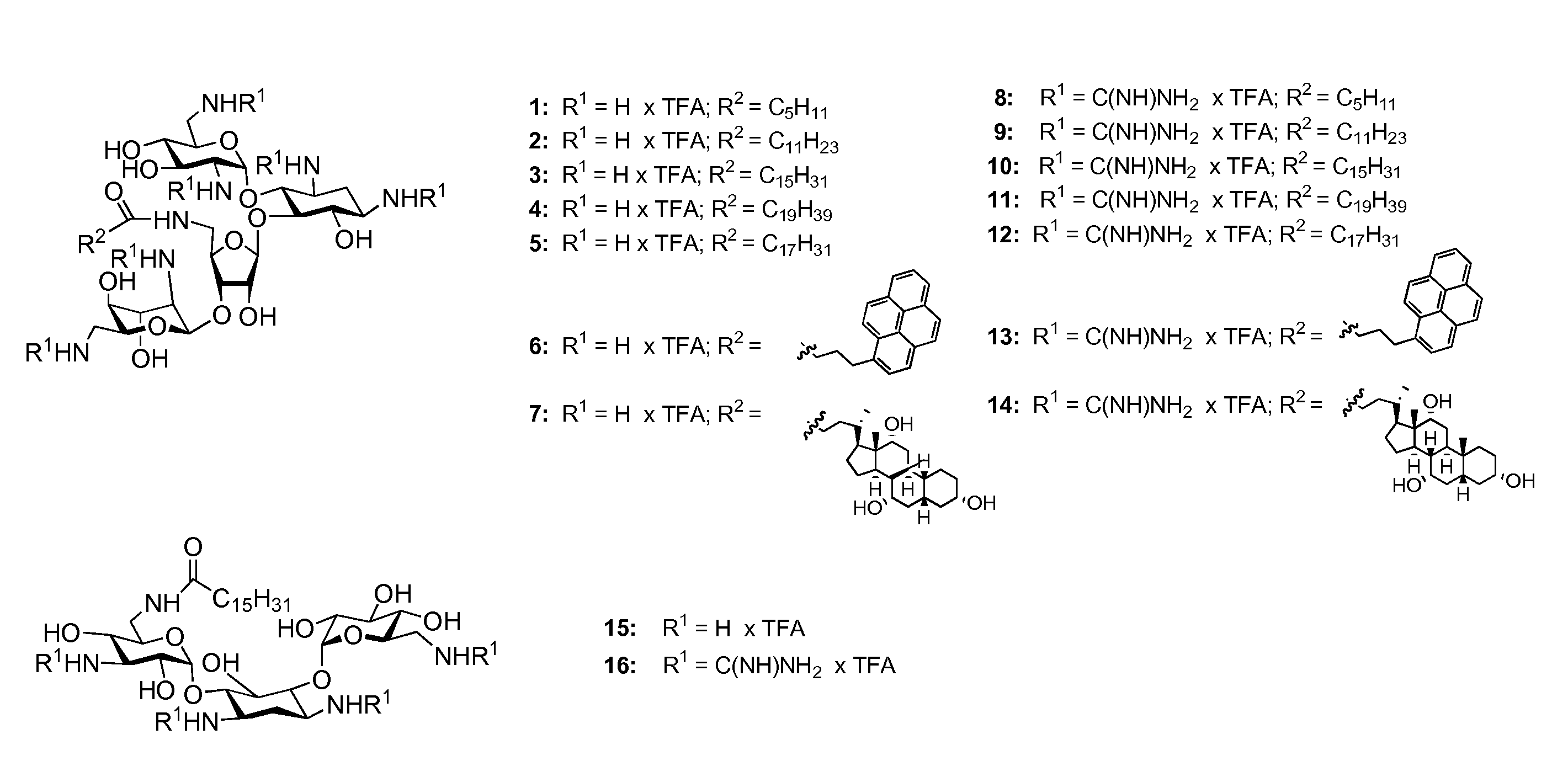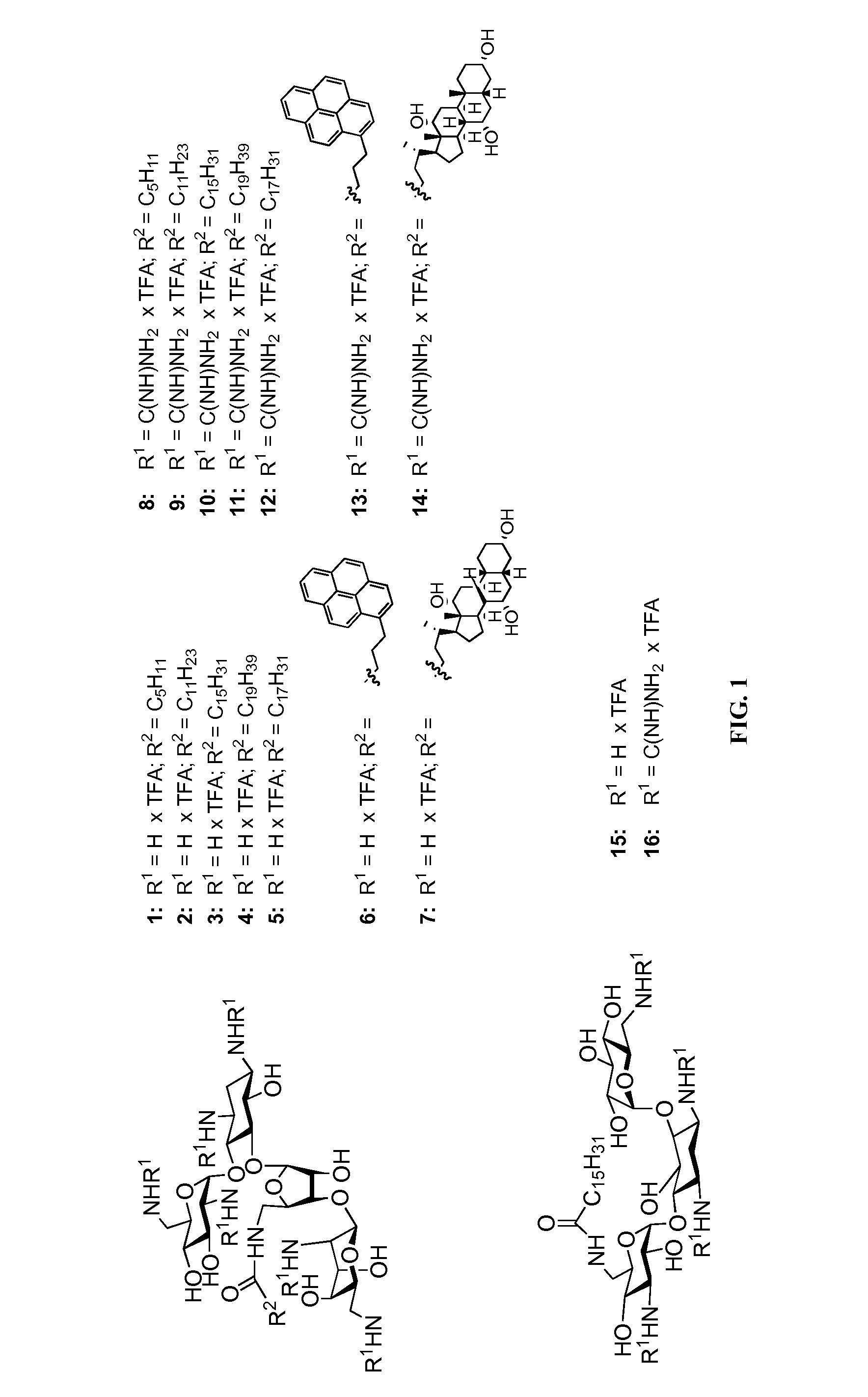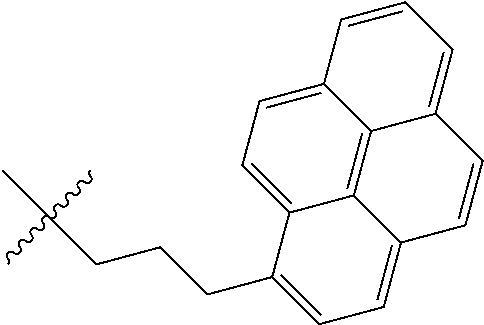Guanidinylated aminoglycoside-lipid conjugates
a technology of aminoglycosides and conjugates, which is applied in the direction of biocide, sugar derivatives, pharmaceutical non-active ingredients, etc., can solve the problems of increasing the number of antibiotics that cease to be clinically effective, and the need for novel antibacterial agents with reduced resistan
- Summary
- Abstract
- Description
- Claims
- Application Information
AI Technical Summary
Benefits of technology
Problems solved by technology
Method used
Image
Examples
example 1
Synthesis of Various Aminoglycoside-Lipid Conjugates
[0081]The guanidinylated aminoglycoside-derived cationic lipids 8-14 were prepared from the known aminoglycoside lipid conjugates 1-7 by guanidinylation of the amino groups using N,N′-diBoc-N′-triflylguanidine as previously described followed by deprotection with trifluoroacetic acid and purification on reversed-phase C18 silica (Bera et al., 2008; Baker et al., 2000). The same synthetic strategy was used to prepare kanamycin A-based polycationic lipids 15 and 16. The identity of the synthetic cationic lipids was assessed by electrospray ionization-mass spectrometry, 1H nuclear magnetic resonance and 13C nuclear magnetic resonance and the purity (>95%) was assessed by elemental analysis (see Example 2).
[0082]NMR spectra were recorded on a Brucker Avance 300 spectrometer (300 MHz for 1H NMR, 75 MHz for 13C) and AMX 500 spectrometer (500 MHz for 1H NMR). Optical rotation was measured at a concentration of g / 100 mL, with a Perkin-Elme...
example 2
Characterization Data for Compounds 8-16 1,3,2′,6′,2′″,6′″-Hexaammonium-guanidinyl-5″-deoxy-5″-N-(hexanoyl)-neomycin hexakis(trifluoroacetate) (8)
[0088]Yield=91%; Rf 0.10 (NH4OH / MeOH / CH2Cl2 2:6:4); 1H NMR (300 MHz, CD3OD): δ 5.91 (d, 1H, J=4.2 Hz), 5.12 (d, 1H, J=4.2 Hz), 5.02 (s, 1H), 4.23 (t, 1H, J=6.1 Hz), 4.10 (t, 1H, J=5.1 Hz), 4.06 (d, 1H, J=3.2 Hz), 4.01 (t, 1H, J=3.2 Hz), 3.96 (dd, 1H, J=5.2, 9.0 Hz), 3.80 (m, 4H), 3.64 (m, 6H), 3.55 (m, 2H), 3.50 (m, 3H), 3.39 (m, 2H), 2.26 (t, 2H, J=7.1 Hz), 2.15 (dt, 1H, J=2.9, 13.3 Hz), 1.76 (t, 1H, J=10.7 Hz), 1.61 (quintet, 2H, J=7.4 Hz), 1.34 (m, 4H), 0.93 (t, 3H, J=7.7 Hz); 13C NMR (75 MHz, CD3OD): δ 177.1 (amide C═O), 159.6, 159.5, 159.3, 159.2, 158.6 (Guanidine C═NH), 111.5, 100.5, 97.1 (anomeric carbons), 87.8, 82.4, 82.4, 79.8, 77.5, 76.6, 75.7, 74.1, 72.0, 71.4, 70.9, 69.0, 57.1, 55.3, 53.6, 51.7, 43.1, 43.0, 42.0, 37.1, 33.8-23.4 (aliphatic CH2), 14.5 (aliphatic CH3); [α]D25=+22.0 (c 0.86, MeOH); ELMS: calcd for C35H70N19O13+ 9...
example 3
Antibacterial Testing of Various Aminoglycoside-Lipid Conjugates
[0101]A total of 7 neomycin B-based and 2 kanamycin A-based polycationic lipids were synthesized (FIG. 1) and their antibacterial activities were assessed (Table 1). A variety of lipophilic moieties including C6-, C12-, C16-, and C20-, double-unsaturated C18-, pyrene and cholic acid were selected to explore how the nature of the hydrophobic tails affects the antibacterial activity. Neomycin B and kanamycin A were selected due to their commercial availability in multigram quantities, low price and well documented resistance profiles. In addition, both aminoglycosides allow exploration of effects caused by structural differences in size and number of cationic charges. Gentamicin, neomycin B and kanamycin A served as positive controls.
[0102]American Type Culture Collection (ATCC) strains as well as clinical isolates from the Canadian Intensive Care Unit (CAN-ICU) study were used for susceptibility testing including includi...
PUM
 Login to View More
Login to View More Abstract
Description
Claims
Application Information
 Login to View More
Login to View More - R&D
- Intellectual Property
- Life Sciences
- Materials
- Tech Scout
- Unparalleled Data Quality
- Higher Quality Content
- 60% Fewer Hallucinations
Browse by: Latest US Patents, China's latest patents, Technical Efficacy Thesaurus, Application Domain, Technology Topic, Popular Technical Reports.
© 2025 PatSnap. All rights reserved.Legal|Privacy policy|Modern Slavery Act Transparency Statement|Sitemap|About US| Contact US: help@patsnap.com



